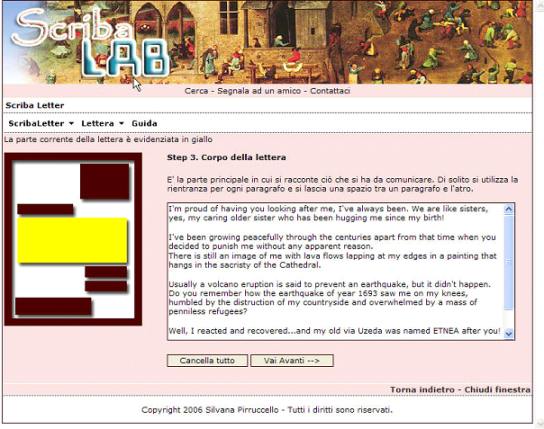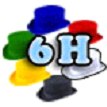ScribaLab Ver. 1.0 - digital writing @ school
Nuccia Silvana Pirruccello, Italy
Nuccia Silvana Pirruccello is a teacher and ICT teacher trainer in Italy. She has presented and discussed six ICT teaching experiences at TESOL-Italy National Conventions from 2000 to September 2005. She is presently working as a e-tutor in post lauream courses with the University of Florence and running blended online courses for in-service teachers, students and adults through her personal platform http://www.funteaching.it/. Enjoys working with ICT and multimedia E-mail: silvana@funteaching.it
Menu
Introduction
First Considerations
Personal tools: ScribaLetter
Collaborative tools: Scriba6Hats
ScribaLAB Community
Scribalab is an Italian-English dynamic website for writing skills.
Most of what is offered as interactive materials on the net consists of video-animations, creative art, multimedia stuff which attract users as information consumers. They are not allowed to do much in terms of participating, contributing or producing. They can surf the sites, search and read the information, but rarely they are allowed to create and edit digital contents.
What is Scribalab?
A system to create web communities and a modular toolbox for writing and publish on the web. It is made up of two main sections both designed to welcome users and visitors. You can find challenging and interesting tools into the Scriba section, such as ScribaMapping or Neverendingstory with suggestions for cooperative group activities on creative writing or having the opportunity to create a podcast of your choice in Scribapodcast. The tools offered to the users are both personal and collaborative.
A special section is reserved to the teachers who want to create collaborative learning objects to develop writing skills on the fly.
Our fundamental question is: "How can the users be motivated to practise writing in the cyberspace?" Let's look at these four points.
- Interface: the users need to be brain friendly connected to the materials offered, control and manipulate them comfortably and produce their own piece of writing.
- What the users can do: they can choose the categories of their interest, work on their own or use personalized tools, helpers and guidelines.
- Media combination modalities: the interactive lab generates static contents as well as web pages contents on the fly such as text files, audio and video files. In order to meet the requirements of the different writing modes, a section for video-clips streaming publication has been complemented.
- Workflow management and tools: the workflow is linear in the process of submitting and validate an article whereas the users' tools are designed to write a guided article according to the technique of the inverted pyramid Scriba5W or to map a story (ScribaMapping).
ScribaLAB has a series of personal tools such as ScribaLetter, ScribaMapping and Scriba5W. As for a start we would like to present one personal tool in detail: ScribaLETTER.
Once the student is logged on his personal tools page, he can choose between a friendly letter and a business letter layout. The latter is introduced by a model letter in which the student is guided to become aware of the different parts of the letter by moving the mouse pointer on the Heading, the Inside Address, the Greeting (also called the salutation) the Body of the letter, the Complimentary Close and the Signature Line.
This is what he is told: 'Click your mouse pointer on any part of the picture for a description and example of that part'.
If he chooses to write a formal letter as the model suggests, he will be gradually introduced to the six graphic organizers, one for a single part of the letter, and guided in his/her writing process step by step.
The format for a personal letter is slightly different. Personal letters, also known as friendly letters, and social notes normally have five parts. However, the student is assisted in the writing process with some interactive suggestions as well.
The format can even be adapted for creative letter writing. The following screenshot shows how ScribaLAB has been used by my students on an activity suggested by Mario Rinvolucri during a teacher training seminar in Catania (Sicily).

It was natural to ask students to do collaborative creative writing in the computer room rather than in a computer less classroom. The letters shared between Catania and Etna were printed and saved.
The collaborative tools in ScribaLab are Neverendingstory, a cooperative story making tool with alternatives on the style of game-books, ScribaPodcast for mp3 file production and Scriba6hats which is being described in detail.

Scriba6Hats has been designed as a mini-forum with thinking types based on Six Thinking Hats method by Edward de Bono. De Bono points out that one difficulty we often encounter when thinking is confusion. Our emotion and logic and creativity all vie for our attention. When we focus on one thing at a time, however, the whole process becomes less confusing, much easier and more productive. Students can practise six hats thinking on a wide range of topics. The emphasis is on using six hats thinking on a problem that confronts the class as a group or is troubling an individual student. As you wear each hat, you focus only on that hat's quality before posting and the possibilities of a good discussion forum are being implemented.
- Begin by asking someone to state what the problem is. Wearing the white hat, we or our students can examine the facts in an objective manner. Focus on the presentation of pure facts and information. Like a computer, the white hat thinker isn't coloured by any particular emotion.
- The blue hat represents to being logical and applying the ability to think about thinking. At any point , we and our students might take a look at facts through the cool, controlled approach of the blue hat.
- Emotions are signified by the red hat: "What feelings does this problem bring up in you? What intuitive feelings and hunches do you have?2. The red hat reminds us that there is an appropriate place for emotions in our thinking.
- The world of imagination and creative, fertile ideas is part of green hat thinking. Students can be encouraged to let themselves go and see what ideas show up while wearing a green hat before posting their messages.
- Any negative feelings, judgments, and ideas about what won't work belong to the space reserved for black thinking.
- To balance the black hat try on the yellow hat and take an optimistic look at what is possible. Constructive ideas and opportunities are to be posted under the yellow hat thread.
In the end the teacher-moderator of the discussion forum and the students may wish to return to the blue hat to review the process and take a final look at the discussion threads.
All the people who like writing can join the community and share their experiences in synchronous working sections or by writing reviews on published articles and stories. Registered users can also use personal and collaborative tools. The central idea is that writing is important and stories are important, too. We need stories; they are all around us, on television, in newspapers, magazines and books and also...in ScribaLab. Why not?
See and download the PowerPoint Presentation at for more information
www.funteaching.it/files/tesol05_001.pdf
The speakers will introduce you to ScribaLab: an interactive lab where you can find challenging and interesting topics, such as the interactive history of writing or some writing games with suggestions for cooperative group activities. Once you get into the Lab room, Mr Scrib, with his video-tutorials, will introduce you to your tools and gently let you write a personal or formal letter, an article or a cooperative never-ending story.
ScribaLab is a place for writing, for a potential writing along with reflections on communication, history and the state of the art in teaching and learning. You can find challenging and interesting topics into the Scriba Room, such as the interactive history of writing or some writing games with suggestions for cooperative group activities in the platform or stimulus stories for teachers, teacher trainers and thinkers. Topics range from children pre-writing experiences to creative or professional writing for students and adults, to web writing. Enjoy the world of writing with your community at ScribaLab House!

Please check the What's New in Language Teaching course at Pilgrims website.
Please check the Creative Methodology for the Classroom course at Pilgrims website.
Please check the CLIL - Teaching Other Subject Through English course at Pilgrims website.


|